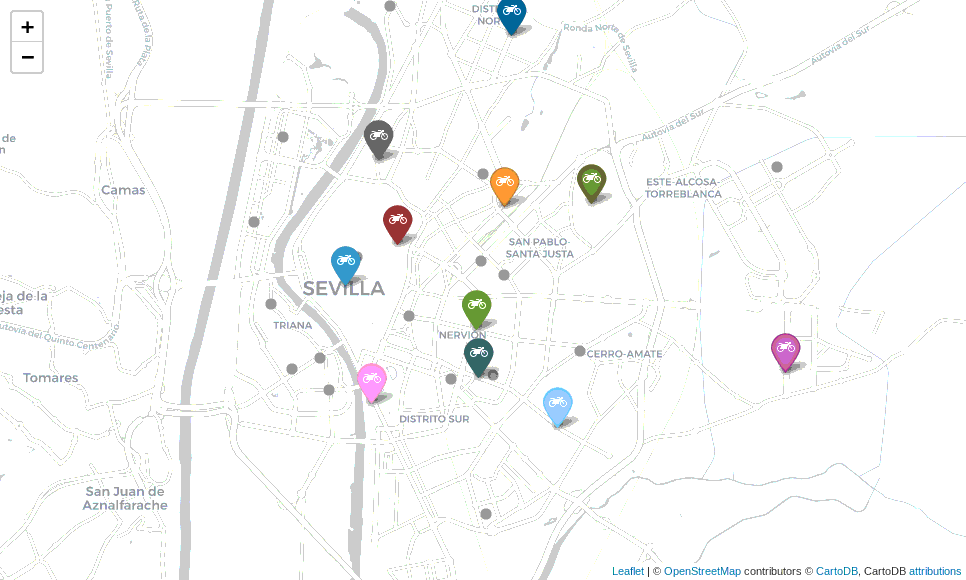Sustainability

October begins and BlackFriday is getting closer and closer, it's time to get ready and be ready for its arrival. In this article we want to discuss the challenges faced by e-commerce and the last mile today.
Cumulative sales between BlackFriday and Christmas account for 30% of annual turnover for some e-commerce sectors. That is why it is very important for the sector to be able to know what challenges it will have to face this year.
In recent years, e-commerce has grown steadily, especially with the momentum it gained in 2020 as a result of the covid19 pandemic. Now in 2022 and with another economic context, it seems that this growth is slowing down and is almost stagnant. Specialists anticipate that this year there will be fewer offers, due to the economic context, lack of stock and reduced production.
In this context, new challenges are presented for e-commerce. First, end customers continue to push for speed, flexibility, and convenience. Get everything delivered to your doorstep. However, on the other hand, they also prioritize companies that are more sustainable and reduce their emissions. In any case, many forget about this aspect and the perception of the negative impact on sustainability is reduced compared to the convenience of receiving their order at the time they want. Then there is a dichotomy for logistics companies: to be faster or to be more sustainable. Perhaps the answer is neither of these two options but rather the convenience in delivery.
Second, there is an accessibility problem. In recent years, the Internet has allowed access to e-commerce everywhere, even the most remote, and this pushes distribution to go further and further. But in terms of logistics and especially infrastructure, not so much progress has been made, which is why it is costly and even difficult to reach remote towns and areas, especially in less developed countries.
Thirdly, the post-pandemic era, the modality of free returns for online purchases has become widespread, which presents a Great reverse logistics challenge. Offering free returns also poses a duality since it is not sustainable for packages to travel long distances and then return, wasting fuel and generating costs and emissions. In the future, it should be reviewed if it is convenient to provide a free returns service, if it is necessary to charge it or encourage the customer to approach a physical store to add this reverse logistics, minimizing trips.
Finally, another challenge is to improve the user experience: essential in this era when people place a lot of weight on the opinions of other customers, in addition to their own, and decide to repeat their purchases where they have received the best service. To improve reliability, there are tools such as order tracking, proof of delivery, direct communication with the customer, satisfaction or opinion surveys, among others. Taking care of and improving the user experience throughout the year is possible when you use a logistics service that has these tools, allowing more reliability and transparency for the end customer. The quality of the service is what sets you apart from the competition.
Our main recommendation for this BlackFriday is to anticipate. There is still time left, specific strategies can be planned for this date, not only for marketing and advertising, but also for logistics, to be prepared for increases in demand. In addition, we believe that technology is the main solution to many of the challenges posed in last-mile distribution.
That's why we encourage you to try Routal, a digitalization tool where you can optimize your delivery routes, use the restrictions your operations need, control routes in real time, send direct communications to the customer to keep them informed and reduce failed deliveries, collect proof of delivery, send customer and driver satisfaction surveys, as well as reduce costs and time in your operations. Test Routal free for 10 days by clicking hither.

This year the European Mobility Week is celebrated from September 16 to 22 with the motto “Combine and move!” to place the emphasis on intermodality. The celebration will begin on Friday, September 16 with Park (ing) Day and will end on September 22, World Car Free Day.
The objective of the European Mobility Week is to raise awareness of the need to reduce the use of private motorized vehicles, in order to achieve a less polluted city and also reduce the space usually occupied by these vehicles. As well as promoting more sustainable travel such as public transport, cycling or walking.
As part of this event since Routal we want to tell you how we apply our contribution to the sustainability of the city and how we reduce CO2 emissions when it comes to moving to the office.
Since 2020, Routal has left the employee free choice to work from home or go to the office. Routal currently employs 10 people. The offices in Barcelona are located in the center of the city and are easily accessible by public transport. However, working from home is everyone's favorite option. When we decided to meet at the office, we traveled by bike, scooter, on foot or by subway.
Avoiding the use of private motorized vehicles and working from home has meant savings in emissions of 6,733 kg of CO2 per year (6.7 tons) for Routal.
You can encourage your employees to work from home to avoid large CO2 emissions every year as well as improve work-life balance. Our own CEO (who has just become a father for the second time) is grateful to be able to take his daughter to school every day 😄 and not miss a school party. It's a matter of organization and flexibility, he says.
However, if working from home isn't possible at your company because the type of work doesn't allow it, you can help your employees reduce their emissions. A practical way is to share a vehicle between several. For this purpose you can use Routal to see how your employees could easily and quickly carpool. You just have to enter the addresses of all your employees, adjust the number of vehicles that may be needed, and we take care of planning the most efficient routes for them to share their vehicles. Watch the video:
As a company, we are aware of the need to improve the world of our children and that is why we work not only to offer a better service but also to help our customers with their environmental objectives, reducing emissions, improving the quality of their deliveryers' work and offering a more convenient service to their customers.
If you're wondering how we do it, I encourage you to look This other video and you'll see how we can save you hundreds of liters of fuel every month and thousands of hours behind the wheel every year.
You can do your route by trying Routal free for 10 days by clicking here.

Sant Jordi is always a special day, books, roses, queues and people, lots of people. Everyone is out on the street, enjoying a magical day for both children and adults. It is the day of the year when the most books are sold, 7.5% of annual sales In the city of Barcelona.

This year will be special. We'll have to spend it at home, enjoying a good read, our recommendation for these days The Black Swan by Nassim Taleb. This year we will save ourselves the hassle of Las Ramblas and we will have to buy the roses online. Without a doubt, a special year.
We want to take advantage of this important date to see the success of initiatives that, in a normal year, would hardly have achieved such overwhelming success.
One of our customers Santjordiacasa.com is using Highway as a tool to optimize the distribution of roses on such a special date as Sant Jordi.

Thanks to the power of the Highway route planner, they have been able to grow in deliveries and reach customers that would have been impossible for them before.
Like them, hundreds of other customers are entering a world such as home delivery. A channel that had often been completely forgotten. Thanks, or unfortunately, COVID-19 has forced the launch of new marketing channels such as Ecommerce and its own distribution and home delivery.
We are seeing this in our traditional customers, distribution companies to the HORECA channel that are converting to home distributors overnight.
Pastry shops such as Cropics they were able to deliver all the Easter monkeys in record time and have the detail of leaving a monkey at my wife's grandmother's house 😁. These types of details make being able to help small businesses make you proud of the work you do and of seeing how you can help more people around you.

We are in a very difficult time for many companies and families. There is little help to get through this crisis and reaching those people we can help is always a challenge. I encourage you to share our story, the story of our users and customers, companies that are embarking on a new adventure, delivery. Without experience, without processes, but with a desire to fight and face the corona, you are not alone.
We won this together.

The distribution on demand is an industry that is growing at a very high speed. New companies appear every day, especially in the market for food, beverages and deliveries of perishable products. And the competition is wild. Efficiency is a key metric in the “I want it all and I want it now” era and the most critical part is what happens from when a new order is placed until it is delivered.
Today I want to focus on the problem of sending new orders, that is, how to decide which courier service the order should be assigned to when an order enters the system. This is because the dispatch today is not addressed systematically. Optimizing the dispatch system can minimize delivery time and improve customer satisfaction.
The operating paradigm of companies that deliver on demand can be divided into two different types:
- Operations based on a single warehouse are those operations focused on a single tank. This warehouse has several dealers and the programming is done once to obtain an order list; usually grouping orders by area. Amazon Prime is a good example of this paradigm.
- Operations based on multiple warehouses are those operations that rely on choosing the order in one of the multiple warehouses and delivering it to a customer. In this case, the delivery people are scattered around the city, and once a new order arrives, it is assigned through a shipping process to one of the multiple delivery people. Companies such as Uber, Just Eat, Delivero, etc. operate this way.
The problem of dispatching is solved more or less satisfactorily in the first scenario thanks to the possibility of linking together a list of deliveries and considering it as a Traveling Seller Problem (Traveling Salesman Problem) with some pre-clustering restrictions (OK, I know that TSP is an expensive problem, but... come on, it's about Amazon).
On the contrary, in the second scenario, it is not so clear that the problem is being optimally addressed. How can a new incoming order be added to a running scenario? There are tons of variables to consider:
- Can the courier make multiple collections before starting to deliver?
- Can an already assigned order be reassigned to another courier service?
- Do all orders have the same priority? (for example, all orders must be delivered no later than 30 minutes after placing them)
Do orders need to be delivered by a particular vehicle? - ...

Modeling this scenario can be quite challenging, and that's why SmartMonkey has been working on this problem for a while. We call our solution Online Programming Optimization Model (OSOM) (Yes, branding isn't one of our strengths 😅, but phonetically it sounds like “incredible” and that's pretty fun). OSOM can model business restrictions and find a feasible solution to the dispatching problem.
In the simulation below, we have modeled a world where:
- A courier service can be assigned multiple pickups and deliveries at the same time
- and the first next service of each messaging service is fixed and cannot be reassigned in subsequent iterations.
The visualization contains twenty iterations of the world divided into two steps:
1. New incoming services are marked in gray.
2. Services are dynamically assigned to deliverers to optimize overall delivery time.






.png)


